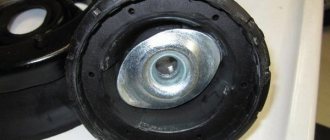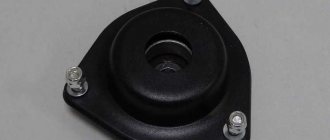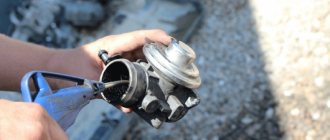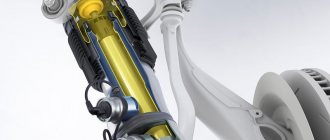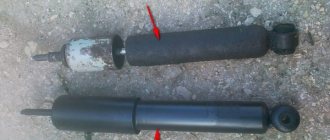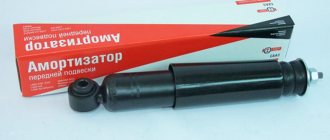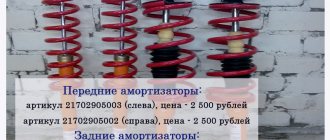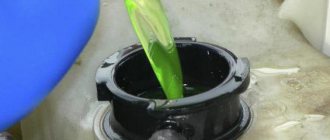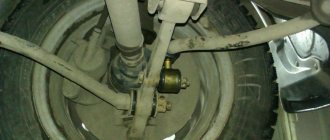A faulty shock absorber strut can be determined without removal: indirect signs and visual inspection are sufficient. It is important to carry out replacement and repairs in a timely manner. Since the safety of the driver, passengers and other road users depends on the proper operation of the part.
There are as many as 4 different methods for checking the strut without removing it:
- careful inspection; for this purpose it is advisable to remove the wheel;
- monitoring work under load;
- monitoring the car in motion on turns, when driving over uneven surfaces;
- measurement.
Visual inspection
The first thing you need to pay attention to is the appearance of the rack itself. Sometimes it will tell you much more about its condition than other testing methods. If the stand is leaking or is wet, it is advisable to replace it. To be sure of the diagnosis, you can simply wipe the surface of the shock absorber with a dry cloth. Then repeat the inspection a few days later.
It is advisable to lift the car on a lift: the shock absorber rods should shine. If there are traces of rust or other defects, this indicates that the part is not working properly. Another indirect sign is the presence of defects on the car tires. The presence of uneven wear indicates an asymmetrical load. Among other things, it is important to assess the condition:
- protective kit - boots, springs;
- upper supports.
Shock absorber repair using a repair kit
It should be said right away that only twin-pipe shock absorbers can be repaired.
For repair you will need:
- Shock absorber repair kit;
- Oil for automatic transmissions;
- Special key for the upper shock absorber cover;
- Lots of clean rags;
- Degreaser (brake cleaner).
You can purchase all this at a car store.
To carry out the shock absorber repair procedure, you need to maintain maximum cleanliness in the workplace. Even the smallest grain of sand that gets inside the shock absorber can damage it.
First you need to remove the shock absorber from the car and clean its body. After this, unscrew the top cover of the shock absorber and disassemble it. For greater reliability, write down or photograph the relative positions of the shock absorber parts. Then, wash off the old oil and degrease all metal parts of the shock absorber. Replace all rubber bands in the shock absorber with new ones from the repair kit. Fill the shock absorber with new oil and tighten the cap. After this, you should pump the shock absorber; to do this, install the shock absorber vertically with the rod up and gently press the rod several times.
After these procedures, the shock absorber is ready for installation on the car.
Load on the car body
The old, old-fashioned method is to rock the car body and see how the racks work out this movement. If after one shock the shock absorber has made more than 1 translational movement, then it is time to change it. But you need to remember: this method will only be relevant if the shock absorber is completely “dead”. It will also allow you to identify a jammed shock absorber. It will be simply impossible to rock the body.
Steering wheel jerking
When moving evenly along the highway, the car may be exposed to strong gusts of wind, which provoke body deflections and disruption of the trajectory. Old struts cannot absorb these vibrations, which is why the car yaws and the steering wheel begins to twitch in your hands. The body squats unpleasantly on one side, and the car steers strangely to the side. This is dangerous on slippery and wet roads due to the risk of skidding. An inexperienced driver may not be able to correct trajectory changes well enough and twists the steering wheel, causing the car to risk completely losing control.
Management, operation
Indirect signs of faulty shock absorber struts - problems when operating the machine:
- the wheels “yaw” when driving over uneven surfaces;
- there is a swing in different directions - for no apparent reason;
- lack of normal feedback on the steering wheel.
It must be remembered: such signs of faulty struts are present not only at high speeds. But even if the speedometer is much less than 60 km/h. It is important to remember that deterioration in controllability is one of the first signs of a malfunction not only in the steering system. But also shock absorbers.
Pull when braking
If the car moves to the side during heavy braking, then this is also a reason to check the performance of the shock absorbers. Loss of directional stability is caused not only by jammed caliper pistons or soured brake pads in the grooves. Sometimes the culprit is incorrect wheel alignment, caused by errors in the repair of struts or their incorrect installation.
What malfunctions occur due to wheel imbalance? More details
Measuring distances and sizes
One of the simplest and most accurate ways to determine the presence of a malfunction is to measure the gaps and dimensions. The optimal solution: take it to a service station. Qualified technicians will definitely help determine whether replacement is necessary. It must be remembered that even one faulty shock absorber affects the efficiency of the vehicle’s suspension system.
It must be remembered that working with a stand in a workshop implies the need to configure it for a specific car. For example, it often happens that the data indicated almost complete wear of the car’s suspension. At the same time, on the road, regardless of speed, the car behaved perfectly. The reason was simple: the stand was simply not configured to work with a rigid suspension.
Try it on!
The simplest, fairly quick and not so expensive way to get general information about the effectiveness of the suspension is to stop by a diagnostic stand, take measurements and listen to the verdict.
Another question is how precisely the verdict will apply directly to shock absorbers. The fact is that in the case of various kinds of “shaking” (of which there are more and more recently), the presence of at least one faulty element (not necessarily a shock absorber) will significantly affect the final results of the efficiency indicator. In addition, the algorithms by which the performance of the suspension are assessed differ, and diagnostics of one car on different stands can lead to the fact that the data obtained on the condition of the suspension may differ.
Suspension knocks and creaks. How to fix
Extraneous sounds often occur in the suspension and shock absorbers. These are knocks and creaks. Most often this is present in the front part of the suspension. Moreover, the reason does not necessarily lie in the rack itself. Sounds can be made by:
- Tie Rod;
- support bearing;
- spherical bearing.
Problems in these units arise more often than in shock absorber struts. Therefore, if extraneous sounds occur, you must first check them. Usually the problem lies in the bearing. Replacing it is not a problem even if you have no experience. A minimal set of tools is enough. The situation is similar with the ball joint.
But sometimes the problem lies precisely in the shock absorber strut. One of the common problems is that the bump stop makes strange sounds. It just falls down the stem. Which leads to squeaking.
The problem may lie in the strut washer: when it does not press the bushing of the support itself well against the bearing. It is necessary to immediately change the washers and supports at the same time. Creaking often occurs in certain situations. For example, on bumps. In this case, the reason in almost 1000% of cases lies in the shock absorber struts. There is only one way to fix this - complete replacement.
Stages of work
Hold the rod with one wrench and loosen the nut with another. Remove it together with the washers and mounting pad. If a lift is used, then at this stage the car can be raised. Unscrew the nuts securing the lever and remove the shock absorber through the hole made in the lever. Remove the cushion from the rod, unscrew the nut securing the assembly to the bracket and remove the spring washer. Now you need to pull out the lower hinge bolt and remove the bracket. Install the new shock absorber together with the hinge. Before installation, pull the rod out to the very end, put the cushion washer on it and screw on the nut. When assembling the mount, you need to lower the upper lift. This will ensure that the unit is loaded with the weight of the machine. If the rod sticks out from the body at an unsatisfactory distance, you can pull it out by using a wrench and tightening the nut. You can use a mudguard to support the key. If you need to change the rack together with the body, then, using devices made from screw ties, you need to perfectly compress the spring, and then remove it. The hooks of the couplers cling to the coils of the spring, and the spring itself is compressed due to the rotation of the rods. You can avoid distortions if you rotate the rods evenly. The compressed spring is installed on a new strut, and all steps are repeated in reverse order. If, while disassembling the shock-absorbing strut, it was found that there is no cartridge inside it, but all the shock absorber parts are present in the assembly, you must carefully drain the oil, install a new cartridge in the strut body and tighten nuts Next, install the spring, support bearing of the strut and screw the nut on the rod. That's it, the shock-absorbing unit is ready.
Shock absorbers provide not only comfort while driving (they smooth out road irregularities). First of all, they care about safety. Thanks to effective shock absorbers, the tires are guaranteed to have constant contact with the road surface. The wheels do not lose traction even on bumps.
If the shock absorber is faulty, the tire bounces over bumps and does not have constant contact with the road. This leads to a loss of stability and an increase in braking distance.
Faulty shock absorbers in cars with ABS and ESP are especially dangerous. Why? ABS constantly ensures that the wheels slow down when braking without locking up. When the wheel locks and goes into a skid, the ABS “releases” the brakes for a split second. When braking with a “tired” shock absorber, the wheel constantly jumps and the tire loses traction. At this moment, based on a signal from the sensor, the ABS system weakens the force on the brakes. Result? Increased braking distance by several meters. In addition, faulty shock absorbers can lead to deviation from the usual trajectory when cornering quickly.
The main problem is that shock absorbers lose their functionality gradually. As a result, the suspension becomes softer and softer, and the driver hardly notices it.
Other symptoms of shock absorber wear are more obvious - oil leaks, frequent ABS activation when braking, car rocking when overcoming bumps or tram rails.
Shock absorbers should be checked during vehicle maintenance. The efficiency must be at least 50-80 percent. Diagnostics are carried out using special electronic devices that examine the damping force and determine the efficiency of shock absorbers as a percentage. Both shock absorbers must have the same efficiency. The difference should not exceed 20 percent.
The driver can check the serviceability of the shock absorbers himself. To do this, you need to “press” on the edge of the wing, then release it and see how energetically the body returns to its original position and how many “nods” it makes (one or several). If there are several vibrations, then the shock absorber is already worn out or even faulty.
What is important is that shock absorbers should always be replaced in pairs, even if one of them is still normal. Why? Because only then is uniform damping and maximum traction of the wheels with the road ensured.
Saving on shock absorber replacement ultimately results in higher costs. The fact is that worn-out chassis elements reduce the service life of other components. Thus, excessive load transfer from the rear to the front axle during braking (due to faulty front shock absorbers) reduces the life of the brake pads. In addition, uneven wear of tires, steering ends, ball joints and silent blocks occurs.
What to do if the shock absorber strut leaks: consequences
Shock absorbers leak due to their design: they are a cylinder that runs in a special sleeve. A special piston moves through a mass of oil or gas (or both at the same time - a combined type). The rod is fixed on it. Thanks to which there is no compression or stretching. The oscillation process itself takes place thanks to the jets.
They are small in size. It is for this reason that the rod moves a short distance, slowly. To prevent oil leakage, the gas outlet from the shock absorber in its upper part is equipped with special seals and gaskets. Thanks to them, the filling of the sleeve does not go beyond its limits. However, with severe wear, oil begins to gradually ooze out. This is due to the following details:
- stock;
- gaskets
The presence of leaking oil indicates that the part is gradually failing or has already failed! A leak indicates that the shock absorber has already exhausted its service life. It needs repair or replacement. A leak is an obvious sign of a suspension problem. Many people ask the question: is it possible to operate a car in this condition? There is no clear answer to this.
For example, if only one rack is out of order, then it is possible to use the car for a short time. But if the struts fail in pairs (two in front or behind), then it is better to stop driving until they are replaced. Because otherwise the car will “toss” along the road like on a roller coaster. Moreover, regardless of the speed of movement. Sudden maneuvers can lead to an accident. Moreover, replacement is best done immediately when the above symptoms occur.
Basic recommendations:
- if one pillar is leaking, then it is possible to use the car for a while without heavily loading the body;
- If 2 or 3 struts are leaking, you need to drive extremely carefully, at low speed and only to the nearest car service center!
When choosing shock absorbers you need to be careful. One of the compromise solutions in terms of price-quality ratio today is KAYABA.
Oil leaks
The malfunction can also be determined by visual inspection. If you remove the wheel and carefully inspect the strut body, you will notice oil smudges on the damaged struts. This working fluid is squeezed out through the broken seals. If a leak develops, the strut will last no more than 3-5 thousand kilometers. If the piston rod is scratched, this is a sign of misalignment and friction against the edge of the strut housing. In this case, the shock absorber has actually already collapsed, does not support the load and requires urgent replacement.
What consequences await the driver when using the current struts?
Many people wonder: is it possible to drive and what are the possible consequences? When operating a vehicle with 2-4 failed shock absorbers, the following consequences will occur:
- the rest of the suspension parts will gradually fail, the body may “behave” - since the buffer in the form of a piston that absorbs shocks and vibrations will be absent;
- the suspension will take the blows and all sorts of rubber components (silent blocks, bushings and balls) will gradually fail - as they will absorb vibrations;
- the distance from the bottom of the car to the ground will be less - which can lead to damage on large bumps (for example, the muffler will simply tear off).
In addition to all other troubles, a decrease in controllability will also be added - it will drop significantly. If a leak has just appeared in the rack, but the oil has not yet had time to leak out, then it will work normally for some time. In terms of time, about 1-2 weeks, no more. If you use a car for a long time with faulty shock absorbers, this can lead to uneven wear of the rubber. Since there will be a skew of the body.
It is not recommended to drive at high speed even with one shock absorber not working. Controllability is significantly reduced, and there is a high probability of getting into a traffic accident. Moreover, the insurance company can easily refuse payment citing a car malfunction. Therefore, it is important to be careful when using a car with suspension problems. And this applies not only to shock absorber struts.
When the first signs of malfunction occur, it is necessary to replace it with a new one. It is advisable to purchase the original. Their resource is an order of magnitude greater, as is their quality.
Why do they break?
Shock absorbers break mainly for two reasons: improper operation and unprofessional installation. Then, as a manufacturing defect, it is no more than 0.5%.
What are the most common shock absorber failures?
- Violation of the tightness of the stem seal. May be caused by aging rubber or damage to the rod coating.
- Violation of the integrity of the rod coating. This defect occurs due to improper installation. Another reason: when the boot is damaged, dirt and sand get inside.
- Failure of internal components: piston or valves. Very durable elements, but a violation of the tightness of the rod seal can lead to foreign particles getting inside, leading to failure.
- External mechanical defects. These are dents, cracks on the body, bending of the rod, which appear as a result of an accident or as a consequence of hitting an obstacle.
- Broken rod thread. Occurs due to violation of tightening standards during installation.
- Broken eyelet. As a rule, the reason is bad roads.
- Destruction of silent blocks. The reason is non-compliance with the rules during installation or violation of the geometry of the fastening when hitting an obstacle.
- Loss of working properties of hydraulic fluid. Any oil deteriorates over time, and hydraulic oil is no exception. Slowly but surely the fluid loses its properties, and the shock absorber deteriorates its performance. The defect is dangerous because it is invisible and gradual.
Special stand
To get a complete picture, it is necessary to check the force of full exit and compression of the rod on a special stand, and in this case it is impossible to do without dismantling it. This diagnosis is the most reliable. The disadvantages include high labor intensity and, ultimately, cost.
After analysis, a decision is made on repair or replacement.
Now let's take a closer look at the causes of problems and how to troubleshoot shock absorber problems. Fluid is leaking from the shock absorber. There may be several reasons for this:
1. There is an excessive amount of fluid in the shock absorber - in this case, simply provide the required amount;
2. The reservoir nut is loose – tighten the nut;
3. The tank is damaged in the area of the sealing ring - replace or repair the tank;
4. Nicks on the rod, wear of the chrome coating - replacement of the rod and oil seal;
5. Damage to the reservoir sealing ring - replace the ring;
6. Damage or wear of the rod seal - replace the seal;
7. Damage or presence of large corrugations on the tank seal - replace the seal.
When driving, the shock absorber makes a knocking noise.
The first step is to check if fluid is leaking - this is often the most common cause of knocking, and if a leak is found, the easiest way is to replace the shock absorber. If there is no fluid leak, perform the previously described test - “rocking the car”. The knocking of the shock absorber can also indicate its wear, and if operation without replacement is more than 60 thousand km, repair or replacement must be carried out.
Another common cause of knocking is air entering the outer cylinder due to a fluid leak. You can fix the problem by bleeding the shock absorber, either with your own hands or at a service station.
A decrease in the density of the liquid due to loss of properties during prolonged operation or the use of oil not specified in the instructions.
